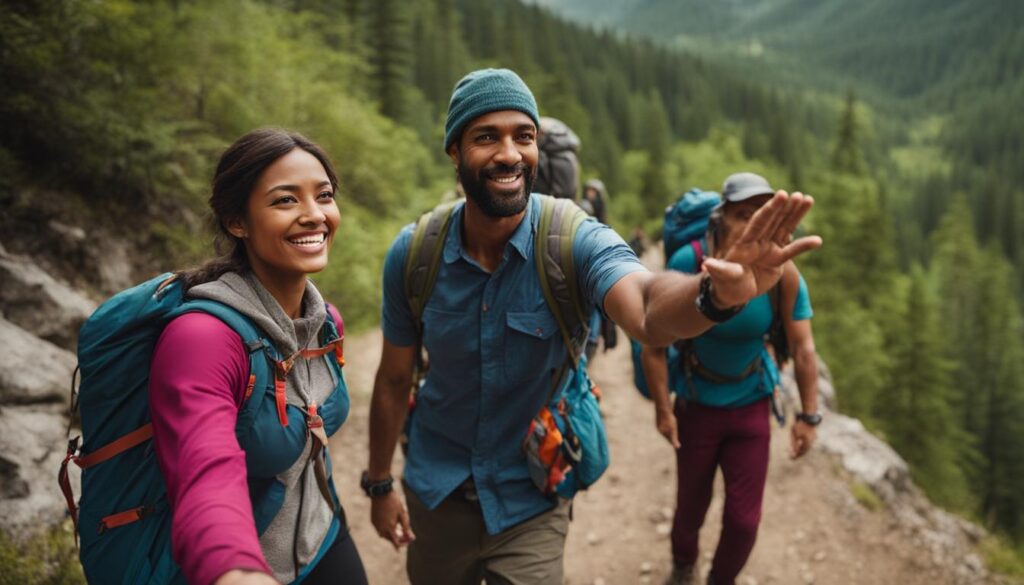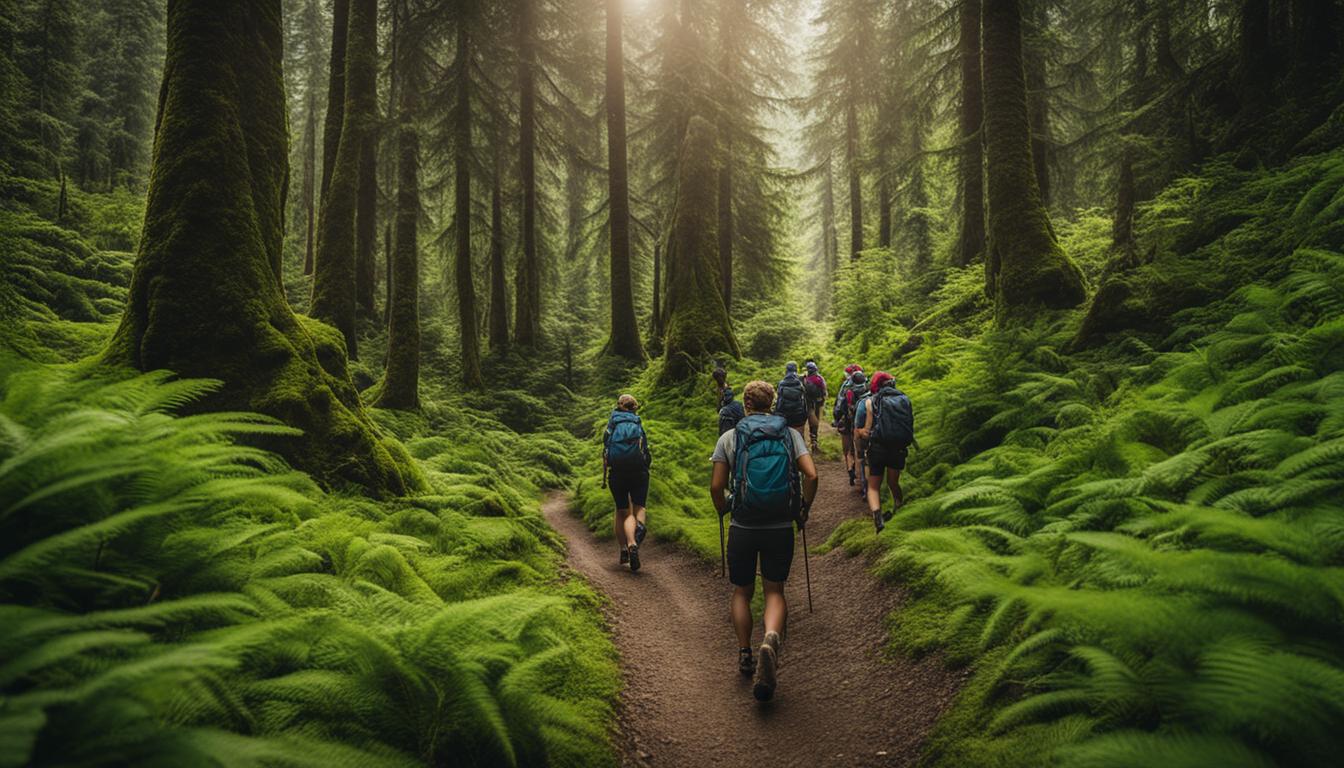As an avid hiker, I know that enjoying the great outdoors comes with a responsibility to practice proper trail etiquette. It’s not just about having a great time on the trails; it’s about showing respect for fellow hikers and the environment we all share. By understanding and practicing trail etiquette, we can ensure a safe and enjoyable experience for everyone.
Key Takeaways:
- Trail etiquette is essential for a positive hiking experience.
- Following the right of way helps maintain a smooth flow of hikers.
- Making yourself known to others creates a welcoming atmosphere on the trail.
- Staying on the designated trail and practicing Leave No Trace principles preserves the environment.
- Respecting wildlife and nature ensures the safety of all involved.
Know Your Right of Way on the Trail
Knowing and following the right of way on the trail is crucial for maintaining a smooth flow of hikers. By understanding the rules and practicing trail etiquette, we can ensure a safe and enjoyable hiking experience for everyone.
Understanding the Hiker’s Right of Way
On the trail, hikers coming uphill have the right of way. This means that those descending should step aside and give space to those climbing. It’s important to be aware of your surroundings and be prepared to yield when necessary.
Trail Signage and Yielding to Other Users
Trail signage can provide important information about right of way and trail rules. Pay attention to any signs or markers along the trail, as they can help guide your actions. In general, bicyclists should yield to hikers and horses, while hikers should yield to horses and other pack stock.
Respecting the Right of Way for a Harmonious Hiking Experience
Respecting and following the right of way not only promotes safety but also creates a harmonious hiking experience. By giving way to others and being considerate, we can prevent accidents and ensure that everyone has an enjoyable time on the trail.
| Trail Users | Right of Way |
|---|---|
| Hikers | Descending hikers yield to those climbing uphill |
| Bicyclists | Yield to hikers and horses |
| Horses | Yield to hikers and other pack stock |
Make Yourself Known on the Trail

When I hit the trails, one important aspect of trail etiquette that I always keep in mind is making myself known to other hikers and trail users. It’s not only a polite gesture but also helps create a friendly and welcoming atmosphere on the trail. So, how do I make myself known?
The first thing I do is greet fellow hikers with a friendly “hello” or a simple head nod. It’s a small gesture that goes a long way in establishing a sense of community. Whether I’m passing them on the trail or meeting them at a scenic spot, acknowledging their presence with a warm greeting helps create a positive hiking experience for everyone.
Another important aspect of making myself known is when I approach other hikers from behind. It’s crucial to announce my presence to avoid startling them. I usually use a calm tone and say something like, “Excuse me, I’m coming up behind you and would like to pass when it’s safe.” This not only prevents surprises but also ensures a smooth and safe passage on the trail.
In summary, making yourself known on the trail through friendly greetings and announcing your presence is a key part of practicing trail etiquette. It helps foster a sense of community, promotes a positive hiking experience, and ensures the safety and enjoyment of all trail users. So, the next time you hit the trails, remember to say hello and make yourself known to your fellow hikers!
Stay on the Trail and Leave No Trace
Staying on the designated trail is not only important for your own safety, but it also has a significant impact on the environment. When you venture off the trail, you risk damaging fragile ecosystems, trampling vegetation, and disturbing wildlife habitats. To minimize your environmental impact and preserve the beauty of nature for future generations to enjoy, it is crucial to stay on the trail.
By following the principle of “Leave No Trace,” you can ensure that your hiking experience remains sustainable. This means leaving rocks, plants, and artifacts where you find them, avoiding unnecessary alterations to the natural landscape. Remember, even small changes can have a lasting impact on the delicate balance of the ecosystem.
Let’s take a look at the table below to understand the importance of staying on the trail and practicing Leave No Trace:
| Trail Behavior | Impact on the Environment |
|---|---|
| Staying on the trail | Preserves vegetation, minimizes soil erosion, and protects wildlife habitats. |
| Going off-trail | Tramples vegetation, damages fragile ecosystems, and disturbs wildlife. |
| Practicing Leave No Trace | Maintains the natural beauty of the trail, preserves artifacts, and minimizes human impact on the environment. |
As avid hikers, it is our responsibility to be mindful of our actions and the consequences they may have on the environment. By staying on the trail and practicing Leave No Trace principles, we can ensure that our hiking adventures leave nothing but footprints and lasting memories.
Remember:
- Stick to the established trail, even if it may seem tempting to explore off the beaten path.
- Respect any signs or barriers that indicate restricted areas or sensitive habitats.
- Refrain from picking flowers or disturbing wildlife.
- Properly dispose of any trash or waste, using designated receptacles if available.
Leave nothing but footprints, take nothing but pictures, and keep the trail pristine for all to enjoy.
Respecting Wildlife and Nature

When hiking on the trails, it is important to always respect wildlife and observe from a safe distance. Approaching animals can be dangerous and disrupt their natural habitat. By maintaining a respectful distance, we can prevent harm to ourselves and the animals we encounter.
Park regulations play a crucial role in protecting wildlife. It is essential to familiarize ourselves with these regulations before embarking on a hike. Some parks may have designated areas for wildlife observation or specific guidelines for encounters with certain species. Adhering to these regulations ensures the safety of both humans and animals and maintains the ecological balance.
As responsible hikers, we should never feed or attempt to touch any wildlife we encounter. Feeding wild animals can disrupt their natural feeding patterns and make them reliant on human food, leading to potential health issues. Remember, wildlife should remain wild, and our role is to observe and appreciate them from a distance.
Respecting Wildlife – My Personal Encounter
“As I was hiking through the lush forest, I came across a family of deer grazing peacefully by the trail. The mother deer gracefully lifted her head, observing my presence. I stood still, appreciating the beauty of this moment while maintaining a respectful distance. It was a humbling experience, reminding me of the importance of respecting wildlife and preserving their natural habitat.”
Essential Park Regulations for Wildlife Observation
| Park | Regulations |
|---|---|
| Yellowstone National Park | Stay at least 25 yards away from large mammals, such as bison and elk, and 100 yards away from bears and wolves. |
| Great Smoky Mountains National Park | Do not approach or feed any wildlife. Keep a minimum distance of 150 feet from black bears. |
| Yosemite National Park | Observe wildlife from a distance and never feed them. Stay at least 50 yards away from bears and maintain a minimum of 25 yards from other large mammals. |
By following park regulations and respecting wildlife, we can contribute to the preservation of their natural habitats and ensure the safety of all involved. Let’s cherish the beauty of nature and foster a harmonious relationship between humans and wildlife on the trails.
Being Mindful of Trail Conditions
When heading out for a hike, it’s crucial to be aware of the current trail conditions and take the necessary safety precautions. Wet and muddy trails can pose risks to hikers, both in terms of personal safety and environmental impact. It’s important to exercise caution and make responsible decisions to ensure a safe and enjoyable hiking experience for everyone.
Wet and muddy trails can be slippery and unstable, increasing the likelihood of accidents and injuries. It’s advisable to evaluate the current weather conditions and recent rainfall before embarking on a hike. If the trails are excessively wet or muddy, it’s best to postpone your hike for another day when the conditions have improved. Taking this precautionary measure not only minimizes the risk of personal injury but also helps preserve the integrity of the trail.
Trudging through muddy trails can result in trail erosion and damage to surrounding vegetation. Stepping off the designated trail to avoid muddy patches can create new paths, leading to the destruction of fragile ecosystems. By staying on the trail and avoiding wet and muddy areas, hikers can minimize their impact on the environment and contribute to the long-term preservation of the trail.
| Trail Conditions | Safety Precautions |
|---|---|
| Wet and Muddy | Postpone your hike |
| Dry and Firm | Proceed with caution |
“Taking the time to assess trail conditions and make responsible decisions is crucial for the safety of both hikers and the environment. By being mindful of the trail conditions and taking appropriate safety precautions, we can ensure a positive hiking experience for everyone.”
In conclusion, being mindful of trail conditions is essential for a safe and sustainable hiking experience. By staying informed about the current weather and trail conditions, postponing hikes when necessary, and avoiding wet and muddy areas, hikers can protect themselves and preserve the natural beauty of the trails. So, before you hit the trails, remember to always prioritize safety and respect for the environment.
Conclusion
As hikers, it is our responsibility to practice proper trail etiquette to ensure the safety of ourselves, other hikers, and the environment. By understanding and following the right of way, making ourselves known on the trail, staying on designated paths, respecting wildlife, and being mindful of trail conditions, we can contribute to a harmonious hiking experience.
Trail etiquette is not just about following rules; it’s about showing respect for fellow hikers and the natural world around us. By yielding to others, we create a sense of community and prevent accidents. Making ourselves known through friendly greetings or announcing our presence helps foster a welcoming atmosphere on the trail.
Staying on the designated trail and practicing Leave No Trace principles are crucial for preserving the environment. Stepping off-trail can have a detrimental impact on wildlife and disrupt delicate ecosystems. By observing wildlife from a distance and obeying park regulations, we ensure the safety of both ourselves and the animals.
Lastly, let’s be mindful of trail conditions. If a trail is wet and muddy, it’s best to choose another day for our hike. This not only ensures our safety but also prevents damage to the trail and surrounding ecosystems. By valuing trail etiquette, prioritizing hiker safety, and preserving the environment, we can fully appreciate the beauty of nature and create a positive hiking community.
What Are Some of the Important Etiquette Tips for Backpacking Trail Behavior?
When hitting the trails, it’s crucial to follow backpacking trail etiquette tips. Always yield to uphill hikers, keep noise to a minimum, and stay on the designated path. Respect wildlife and pack out all trash. Sharing the trail ensures everyone has a positive experience.
FAQ
What is trail etiquette?
Trail etiquette refers to the proper behavior and practices that hikers should follow when on the trail. It involves respecting other trail users, understanding right of way, staying on the designated trail, and respecting wildlife and the environment.
Why is trail etiquette important?
Trail etiquette is important for maintaining a positive hiking experience for everyone. It promotes respect and consideration for other hikers, helps prevent accidents, preserves the natural environment, and ensures the safety of both hikers and wildlife.
What is the right of way on the trail?
The right of way on the trail means that certain users have priority over others. Hikers coming uphill have the right of way, while those coming downhill should step aside. Bicyclists should yield to hikers and horses, and hikers should yield to horses and other pack stock.
How should I make myself known on the trail?
To make yourself known on the trail, you can offer a friendly greeting or a simple head nod when passing other hikers. If you’re approaching from behind, it’s important to announce your presence in a calm tone and let them know you want to pass.
Why is staying on the trail important?
Staying on the designated trail is essential for preserving the natural environment and minimizing the impact on wildlife. Stepping off-trail can damage plant and animal species, disrupt ecosystems, and lead to erosion. It’s also important to practice Leave No Trace principles by leaving rocks, vegetation, and artifacts where you find them.
How should I respect wildlife and nature on the trail?
Respecting wildlife involves observing from a safe distance and not approaching or disturbing animals in their natural habitat. It’s important to follow park regulations regarding wildlife encounters and be mindful of their well-being. By respecting wildlife, we help maintain the ecological balance and ensure the safety of everyone on the trail.
Why should I be mindful of trail conditions?
Being mindful of trail conditions is crucial for hiker safety. If a trail is wet and muddy, it can be dangerous to hike on and can also damage the trail’s condition and surrounding ecosystems. It’s best to turn back and choose another day for the hike when trails are in better condition.

